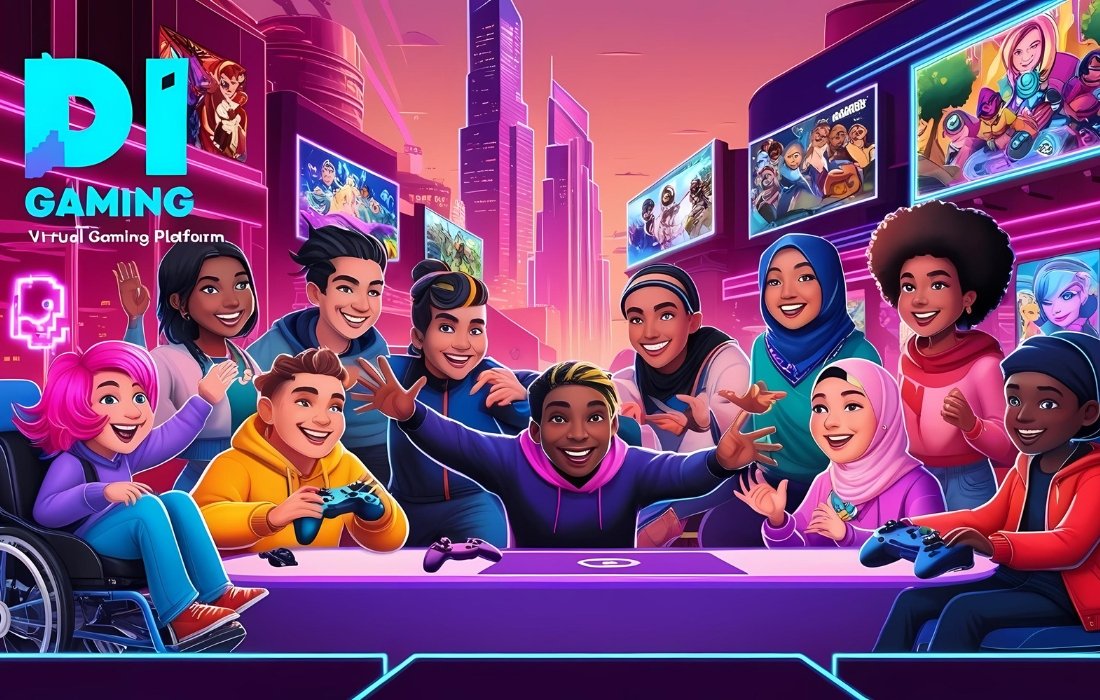Ever wonder what all the buzz is around DEI gaming? You are not alone. DEI stands for diversity, equity, and inclusion; over these past years, it has been a hot topic in the world of gaming. But what does this actually mean to the games that you play and love? Don’t worry we are not here to preach to you. Instead, let’s talk about what gaming DEI really is, why that matters, and how it might actually improve your gaming experiences. Buckle up as we delve into this trend shaking up the industry in some pretty cool ways.
What is DEI Gaming?
DEI Gaming is a growing sensation in the video gaming world to make video gaming more inclusive to all players regardless of their background. But what is DEI gaming all about, really? Let’s dive in and find out about this important concept.DEI gaming focuses on diversity, equity, and inclusion in gaming, ensuring fair representation and equal opportunities for all players.
Breaking Down the Acronym
DEI stands for Diversity, Equity, and Inclusion. About gaming, the definition is as follows:
- Diversity: Manifestation of a wide array of characters from various cultures, ethnicities, genders, and abilities.
- Equity: Non-discriminatory treatment in giving all equal opportunities in playing or developing games.
- Inclusion: Welcoming environments wherein everybody feels important and is treated with respect inside and outside of the game.
The Goals of DEI Gaming
DEI gaming is not about checking a box or making a quota of sorts. It’s actually about adding worth to the world of gaming for all people by:
Share more diverse narratives, which are more relatable to more people. Design characters that reflect different backgrounds-just as would happen in real life. Develop an inclusive community of players in your game-a place where every player feels welcome. Weed out stereotypes and biases in the development process. Why DEI Gaming Matters By embracing these tenets, the industry will be able to open itself to: Increased reach and engagement across new markets Fostering creativity and innovation through a new lens Creating more empathetic and understanding players
Tell the story of inspiring social change by awakening awareness.
DEI gaming is not exclusionary-it’s a movement of making the world of gaming bigger to be representative and inclusive for all. And as an industry that’s always in continuous development, it is because of DEI guiding principles that shape up the future course of interactive entertainment.
The History and Origins of DEI in Gaming
The term DEI gaming might have deeper roots than one might initially assume. To put it simply, it means Diversity, Equity, and Inclusion in the context of gaming. Let’s trace the origins of this movement and how it evolved with time.
Early Stirrings of Change
In the early days of the video game industry, representation was far from a priority. Characters were mostly simple, and diversity was little. But as games grew more sophisticated, so did the conversations around who was being represented onscreen.
First whispers of what would later materialize as DEI gaming had already begun in the 1990s. Games such as “Tomb Raider” introduced female protagonists who were strong in character, while other games, such as “Earthbound,” began to break down stereotypes rather subtly. Small steps, perhaps, but laying the ground for bigger changes to come.
The Rise of Online Communities
Online gaming, starting in the late ’90s and going all the way into the early 2000s, conglomerated players from all walks of life together. That kind of new connectivity has really forced both the diversity of the gaming community and the challenges marginalized groups face into the open. Forums and chat rooms became hotbeds for discussions about representation and inclusion.
Increased awareness, however, came with an increased demand for change. The players started to wonder, “What does DEI gaming really deal with?” And the answer was pretty straightforward: it needed to be a place where everyone could find themselves in the games they love.
A New Era of Awareness
The 2010s became a breaking point. It started with indie games, which dove headfirst into big social issues. More major studios, meanwhile, began incorporating more diverse characters and plotlines into their blockbuster titles.
Today, DEI Gaming is not a buzz phrase; it is a movement that shapes the future of the industry. From character creation options to storylines exploring diverse cultures, the world of games is being crafted to include and evolve with all gamers in mind.
Key Aspects of DEI Gaming
Inclusive Representation
When we refer to what DEI gaming is, representation takes center stage. DEI gaming incorporates characters of diverse backgrounds, ethnicities, genders, and abilities. It is about finding one’s reflection in whatever game he or she is playing, whether it is fighting dragons or solving puzzles. This representation is not superficial, with meaningful storylines and character development that resonates across the wide array of players.
Accessible Design
Another major branch of DEI gaming is accessibility. This means making games accessible for players of different abilities. Think customized controls, colorblind modes, and audio descriptions for gamers who may have visual impairments. It means knocking down barriers so everyone can play along, regardless of physical limitations.
Cultural Sensitivity
Cultural sensitivity in storytelling and video game design is also advocated by DEI gaming. It is beyond the creation of stereotypes, thereby arriving at honest and respectful portrayals of cultures. Such can be achieved through consulting with cultural experts or a diverse writing team that helps to capture accuracy and depth when representing cultures.
Diverse Inclusive Gaming Communities
Finally, DEI gaming goes beyond the screen to build inclusive gaming communities. It’s about creating safe spaces where all players feel represented and valued, no matter their background. This can be anything from designing stringent anti-harassment policies in online games to uplifting the diversity within esports teams and gaming events.
By giving focus to these two key areas, DEI gaming intends to provide an experience in gaming that is more inclusive, accessible, and enriching for everyone. It is not a question of just marking boxes; it’s a total rethink of what gaming can be when it finally opens its arms to diversity, equity, and inclusion.
Benefits of Prioritizing DEI in Gaming
But what’s the real deal with DEI gaming? Basically, it’s about creating a more inclusive, fair game for everyone. Making sure that diversity, equity, and inclusion come first in the video game business, could have some pretty cool benefits real Pandora’s box of pros well beyond the screen.
Building the Player Base
One of the biggest advantages of DEI gaming is its ability to expand into a larger audience base. Diversity-related characters, storylines, and other attributes make games more organically draw in more different types of players. This can only be great for game sales but, meanwhile, enriches the whole gaming community with various experiences and views.
Fostering Innovation
Diversity within game development teams fosters creativity and innovation. People of different backgrounds bring their unique perspectives that can drive landmark gameplay mechanics, compelling narratives, and fresh artistic directions. This will be very important in thought diversity for really pushing the boundaries of what is achievable in gaming.
Improving Representation
The reason DEI gaming initiatives help make sure players see themselves reflected in the games they love, that oftentimes, it can be very profound regarding players’ self-esteem and their sense of belonging within the community. This helps break down stereotypes and fosters deeper understanding among groups of people.
Improved Player Experience
By considering various needs and preferences, developers can build games that more players can access easily and therefore enjoy. This could include things such as controls that can be customized, colorblind modes, or options for different cognitive abilities of players. These options, while meant to accommodate certain groups, ultimately benefit everyone.
Building a Positive Industry Reputation
Companies for which DEI gaming is a priority usually gain a better public perception and customer loyalty as an outcome of it. Gamers love to support brands that prove they can be socially responsible and inclusive. That builds up a circle of long-term success and sustainability within growing market competitiveness.
How Game Developers Can Promote DEI
Game developers have a lot to say about how the landscapes of games are framed, and they can make strong steps toward making their creations fully representative of diversity, equity, and inclusion. But what does DEI gaming really mean? Let’s dive in and get some practical ways that developers foster a more inclusive game environment.
Diverse Character Creation
Thoughtful character design is arguably one of the most impactful ways to foster DEI in gaming. Create a cast of characters that reflect the diversity of the real world: people of various ethnicities, body types, ages, and abilities. Give them depth and agency, rather than falling into stereotypical tropes or tokenism. Inclusive Storytelling
Your game narrative can be a powerful driver of DEI. Craft stories to which a broad diversity of players can relate. Embed diverse perspectives and experiences into your storytelling. For example, you may want to work with writers of all backgrounds to infuse authenticity into your storylines.
Accessibility Features
Make your games playable by everyone with strong features of accessibility: customizable controls, Colorblind modes,, and options for players with hearing or visual impairments to name a few. Bear in mind that accessible design often benefits all players, whether or not they have a disability.
Diverse Development Teams
In the real sense, understanding and applying DEI in video games involves voices of diversity on all layers of game development. Actively recruit and promote team members from underrepresented groups. Create an inclusive environment where every voice is welcome and counted.
Community Engagement
Engage your player community to better understand their needs and perspectives on representation in your games. Hold forums, carry out surveys, and listen for feedback. Take that input and use it to help make future development decisions, showing your commitment to DEI gaming.
With such measures in place, game developers will be further aided in creating more inclusive, representative, and interesting experiences for a wide range of players. Remember, DEI in games isn’t about ticking boxes; it’s about enriching the world of gaming for everyone.
Creating Safe and Inclusive Gaming Communities
So, what is all this, really-DEI gaming? In essence, it’s designing spaces for all gamers to feel welcome, valued, and listened to. Time to learn just how to build them.
Creating Community Guidelines
The backbone of safety in an online gaming community is clear rules. Clearly forbid hate speech, discrimination, and harassment, but be sure to positively reinforce good behaviors, too. Reinforce teamwork, sportsmanship, and respect between all participants. Guidelines should be easy to find and often repeated.
Personalized Moderation
Effective moderation is more than rules and their enforcement. Train your moderators to be friendly and open to the problems the players are facing. They should know how to treat sensitive situations with empathy and justice. Provide a mentorship program whereby more experienced players can be able to mentor new ones and make them part of a family.
Events Celebrating Diversity
Organize in-game events on cultural showcases, different abilities, and perspectives. That could be themed tournaments, character customization contests celebrating diversity, or cooperative challenges that would need diverse skill sets. These events will not only make gaming more entertaining but also give a bit of education to players with respect to DEI principles in an interactive way.
Continuous Learning and Improvement
Making gaming spaces truly inclusive is an ongoing process. Always solicit feedback from your community, and most importantly, from underrepresented groups. Stay up to date on DEI best practices in the industry and be open to changes. Keep in mind that what is DEI gaming today may change tomorrow, so be agile and open to new ideas.
With these methods, we are empowered to create gaming communities that become more than just safe but rather inclusive and empowering for all players.
DEI Issues to Avoid in Game Design
The following are some of the potential pitfalls that concern what is DEI gaming is, which actually undermine this effort for inclusion. A game designer has to be very observant to avoid falling into the trap of either perpetuating harmful stereotypes or excluding certain groups.
Stereotypical Character Representation
One of the major pitfalls in designing games is the reliance by the game designers on stereotypical characters. This can be conveyed in several different ways, such as exaggerated physical features or one-dimensional personality traits based on race, gender, or cultural background. For true inclusivity in games, designers must work toward multilayered, multidimensional characters that mirror the actual diversity of people in the real world.
Limited Accessibility Options
Accessibility in gaming is one of the mainstays of DEI. Most games are completely designed without an afterthought about how players with other abilities it visual, auditory, or motor-can engage in them. Adding things like custom controls, colorblind modes, or even text-to-speech makes all the difference in creating an accessible platform for gamers of all types.
Cultural Insensitivity
So many games draw inspiration from cultures around the world but, without proper research and the input of those groups, often it results in misrepresentation or cultural appropriation. Designers must work with cultural consultants and members of the culture represented sensitively and for the accuracy of representation.
Exclusionary Gameplay Mechanics
Some of the mechanics alone alienate certain groups of players. For example, time-based challenges will be difficult for people with slower reflexes to master; the trend toward complex control schemes would eventually shut out the casual gamer altogether. Inclusive gameplay design must be flexible in terms of player ability and style.
Prejudiced AI and Algorithms
AI systems and matchmaking algorithms can sometimes hold and even amplify biases in multiplayer games. Such systems need rigorous testing to ensure they will not discriminate against players based on username, play style, or other in-game choices that might be correlated with protected characteristics of the players.
Through these considerations, game developers create worlds that are truly inclusive and capture the spirit of DEI gaming by opening their arms to gamers from all walks of life.
Evaluating Representation in Games
When discussing what is DEI gaming is, one of the more vital points is how well diverse characters and experiences are represented in games. Now, let’s explore this very topic: why does it matter, and how does one go about assessing this? Importantly, there’s a dire need to have a diversity of characters within the game.
Ever played a game and felt like there was just nobody that was like you? That’s where representation comes in. DEI gaming creates worlds where everyone can see themselves reflected. It is not about just ticking boxes; rather, it’s about crafting authentic, multi-dimensional characters that resonate with a wide audience.
Now, reflect upon the games you like. How many of them include explicitly diverse protagonists? Are the characters disabled? Do they have different body types and shapes? Are they from the LGBTQ+ communities? These are some of the questions we should ask when analyzing representation in games.
Deeper Than Surface-Level Diversity
Of course, this isn’t all about the character’s appearance. Real representation goes beyond. It’s about:
- Storylines that reflect experiences dealing with diversity
- Voice acting that accurately captures the essence of the character’s background
- Game mechanics that consider a variety of abilities and play styles
When considering what is DEI gaming, think about how the best examples go way beyond token diversity. The best examples are sites in which representation is deeply intertwined within the fabric of the game world to provide richer and more immersive experiences for all players.
Player Impact and Feedback
Representation is not good for diversity; it’s good for video games, period. Gamers from all walks of life bring fresh perspectives into gaming communities. By embracing the core principles of DEI, developers unlock an incredible amount of creativity and innovation.
Next time you fire up a new game, take a minute to consider its approach to representation. Your feedback as a player will shape the future of inclusive gaming. What is DEI gaming without collaboration in making gaming friendly for all?
Conclusion
There you have it in a nutshell: DEI gaming. All it’s about is creating a game atmosphere that’s friendly and inclusive for everyone, whatever their background. Whether you’re an avid gamer or casual player, these DEI efforts set your experience ablaze by introducing fresh perspectives and stories into the virtual worlds we know and love. For developers, this is a chance to look at new markets and unleash their creativity. Sure, there are bumps in the road, but all in all, the gaming industry is leveling up on its diversity front. So next time you fire up that gaming system, take a moment to appreciate how far we’ve come and get excited about where we’re headed next.





